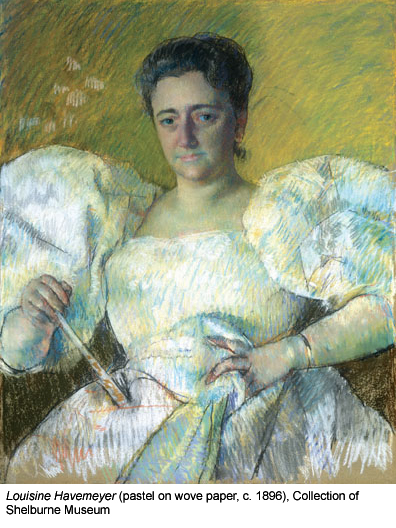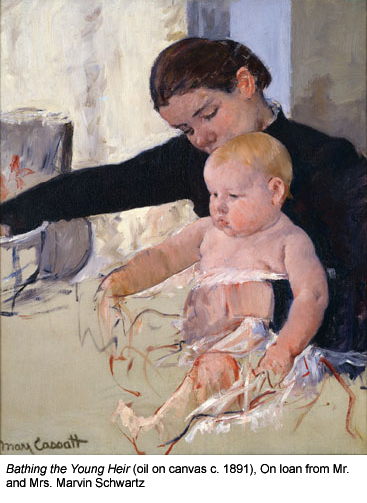Mary Cassatt: Her Brilliant Career,
a Retrospective
By Margaret Michniewicz

Forever obscured to our contemporary eyes - by the array of serene mothers with their cherubic children, or images of refined Victorian-era young ladies replete in their formal wear sipping tea - is the extent to which the artist Mary Cassatt was a rebel in her own time. Personally, politically, artistically, and as a feminist - in all these ways this late nineteenth-century artist was among the cultural vanguard.
Vermonters have the opportunity to enjoy a major retrospective of this extraordinary artist's work at the Shelburne Museum's Webb Gallery between now and October 26. The exhibit, Mary Cassatt: Friends and Family, features more than 60 works - by Cassatt, as well as several pieces by Cassatt's colleague and (on-again, off-again) friend Edgar Degas, and a Monet from the museum's collection. The inclusion of paintings, pastels, drawings, and prints by Cassatt reveal the scope of her artistic talents, which extended beyond Impressionism. And one of the "friends" referred to in the exhibit's title is Louisine Elder Havemeyer, a major figure in the history of art collecting and patronage in the United States. The close personal and professional relationship between these two women is a key dimension to the exhibition.
Today, Cassatt is esteemed as one of the greatest women artists (though it took until the mid-1970s for her - or any women - to be grudgingly accepted into the sacrosanct pages of old school art historian H.W. Janson's History of Art), and she is also hailed as one of the finest American artists of her time. This is in large measure because she was an American, but was not working in America. Virtually Cassatt's entire career was spent in Paris where she lived as an expatriot until her death in 1926. She was in the right place at the right time as Impressionism took the City of Light by storm - and gutsy enough to ditch the art Establishment of the time (the Salon) and take up with a renegade group of artists who referred to themselves as the Société Anonyme des Artistes, soon to be called - disparagingly - "the Impressionists."
Again, it's difficult (if not impossible) with our twenty-first century eyes to appreciate how shocking, and to some appalling, it was for those in the 19th-century to encounter paintings that were done in the Impressionist style. Impressionism has through time become the most popular and widely-beloved of any art style. But upon its emergence, it was met with hostile, even violent reaction, with tales of bourgeois Parisian gents brandishing umbrellas and ladies growing faint (though that might have been the fault of their corsets).
Cassatt, on the other hand, embraced it joyously. In her book American Women Artists, Charlotte Streifer Rubinstein relates this story of when Edgar Degas invited Cassatt to forsake the Salon and join the Impressionists:
At the 1874 Salon, Degas noticed her painting Ida (a bluntly honest head of a cheerful middle-aged woman, painted a la Courbet). He observed… Here is someone who feels as I do…. She was already painting like an Impressionist when Degas visited her studio in 1877 and invited her to exhibit with the Independents (dubbed "Impressionists" by hostile critics). He looked around the room and with characteristic acidity said, "Most women paint as though they are trimming hats… Not you." Cassatt later told her biographer:
I accepted with joy. At last I could work in complete independence without considering the opinion of a jury… I hated conventional art. I began to live."
According to another anecdote shared in Rubinstein, Cassatt was hard-pressed to attain widespread professional respect among her fellow Americans during her lifetime, even after she was well-established in Paris:
When Cassatt, already famous in Europe, returned on a visit to Philadelphia in 1898, the following notice appeared in the Philadelphia Ledger: 'Mary Cassatt, sister of Mr. Cassatt, President of the Pennsylvania Railroad, returned from Europe yesterday. She has been studying painting in France and owns the smallest Pekingese dog in the world.'
A well-known French critic had called her 'along with Whistler, the only artist of eminent talent that America actually possesses.' In Philadelphia she was notable only for owning a small dog.
But the talent of Cassatt was not missed by all of her contemporaries on this side of the Atlantic. Louisine Havemeyer (née Elder) was born in 1855, a decade later than Cassatt - and met the 30-year old artist through a mutual friend when she went abroad to Europe in 1874 with her mother and sisters. Despite their difference in age, this was the beginning of a friendship that would last - with ups and downs - for the next 50 years. According to Nancy Mowll Mathews, curator of this exhibit, it was one of the most important friendships in the history of American art. (Havemeyer, was the mother of Electra Havemeyer Webb, founder of the Shelburne Museum).
As a young woman in her 20s, Havemeyer began to collect works of art, with Cassatt guiding her to astute purchases of modern art by painters such as Degas, Monet, Pissarro, and Whistler - daring choices for a Victorian-era young lady. When the 28-year old Louisine married Harry Havemeyer she soon had vast economic resources to pursue her art patronage and collecting, for her new husband scored big with his family's sugar refining business in an 1887 merger. Over the course of the next two decades, they amassed a collection that featured high-quality work by both modern artists and "old masters," including three Rembrandts. As Mathews notes in the exhibition catalogue, Louisine and Harry were concerned with the general culture welfare of the American public and were great believers in the effectiveness of museums in improving society. Thus, during their lifetime their estimable collection was made available for public viewing, and ultimately was donated to the Metropolitan Museum of Art. For her part,
their great friend Cassatt was invaluable as a savvy advisor on their purchases - she had an innate understanding of the business of art, notes Mathews - and she was also "motivated by the desire to make great art available to American art students and to elevate the quality of American art to European standards."
Kathleen D. McCarthy offers this vivid portrait of Havemeyer in her book Women's Culture, American Philanthropy and Art, 1830-1930:

After her husband died in 1907, Havemeyer became an ardent suffragist. She participated in demonstrations and took to the podium on the movement's behalf. In the process, she became not only a skilled orator but also something of a performer, enlivening her lectures with a battery-powered model of the Mayflower that exploded into the brilliance of thirty-three tiny light bulbs as she described the enlightened future that women's votes would bring, a tactic that inevitably elicited roars of startled approval from her audiences. Perhaps encouraged by her success, she became increasingly militant, to the point of being jailed for her role in a demonstration at which an effigy of President Wilson was burned before the White House gates.
(Nor is it likely that Cassatt would have disapproved: according to Rubinstein, Cassatt was given to describing Wilson in "unprintable" language.)
The Shelburne exhibit features a marvelous photograph of Louisine Havemeyer around 1915, on a boat, wearing a sash emblazoned with the words "Votes for Women", handing off a "torch of liberty" across the water to a sister-suffragette on the other side.
Though these two friends and colleagues lived on either side of the Atlantic, their bond was strong, bolstered through frequent correspondence and periodic visits. The Friends and Family exhibit features a number of the portraits that Cassatt made of Havemeyer and her children over the years, such as Louisine Havemeyer and Louisine and Her Daughter Electra, both in pastel, and a drawing of Louisine's other daughter, Adaline.
Her Own Way of Seeing
Cassatt is best known for her monumental images of mother and child, and this exhibit features them prominently. An entirely different, and compelling, theme in Cassatt's oeuvre is her portrayals of women at the Parisian opera; it is disappointing that this retrospective does not include one of these examples.
Cassatt's presentation of the world maternal is intimate and affectionate, but doesn't devolve to the saccharine. Her images of little children are indeed snapshots, moments caught not on Kodachrome but rather, masterfully rendered by hand through pastel or the simplicity of pencil. The disgruntled mood or bored demeanor of various nieces and nephews and other children she slyly observed are captured for eternity, imbued with a personality rarely, if ever, depicted in art through the ages.
In 1883 at least one contemporary critic appreciated this dramatic departure from the idealized, as related in Rubinstein: "Oh! Those babies! Good grief… how their pictures make my hair stand on end. A whole crew of English and French daubers have painted them in such stupid and pretentious poses. For the first time I have seen family life painted with distinction, a penetrating feel of intimacy."
Much of what makes Cassatt's work dynamic, not just aesthetically lovely, is the unorthodox nature of the composition, with asymmetrical perspectives, compressed spaces, and nontraditional arrangement of the figures. In fact, it is the very idea of there being no premeditated arranging of the personalities portrayed that characterizes Cassatt's work. Her friends and family have been caught on that century's candid camera, as it were.
Of the 50-plus works by Cassatt in this exhibit, all but two portray interior or domestic scenes. Family Group Reading is set outside, with a beautiful green hillside beyond, but it's likely the family's own backyard. Keep in mind that for women of the time, there were definite social restrictions as to who could be out on the street, where and when, and with whom. The feminist art historian Griselda Pollock has written compellingly on this issue of the physical spaces of masculinity and femininity in late-nineteenth-century Paris and the act of being looked at was a factor of risk for the middle-class women in this epoch.
In her book Differencing the Canon, Pollock discusses the theme of one of the two exterior works of Cassatt that are in the Friends and Family exhibit: In the Omnibus. She explains how in Cassatt's time, the omnibus was a "hybrid space - a public space where people of several classes and both sexes are thrown into confusing proximity and potentially 'exciting' situations." Pollock discusses how preliminary drawings of the two women with a baby that we see in the final version originally included a male figure, presumably a stranger and not their companion. She raises provocative questions about what Cassatt had in mind as she altered the scene to omit the male figure, and the complex gender questions that can be investigated through works of art such as this one by Cassatt. Vermonters can ponder this as they view In the Omnibus in Shelburne this summer.
One of the works by Degas that is an especially fine contribution to this exhibit is Au Louvre: La Peinture an etching that depicts Cassatt passing through the museum inspecting the large paintings on the wall. As fleeting a moment as this is intended to convey, according to accounts of Cassatt's appearance and comportment Degas apparently captured her essence superbly. And, we also have the opportunity to get a glimpse of how the artist viewed herself in her 1878 Self-Portrait. Underneath the fashionable trappings of Parisian bourgeois style, the artist gazes away from us, intently scrutinizing something or someone beyond our sight, no doubt envisioning them rendered by her hand.
Mary Cassatt: Friends and Family will be on view at the Shelburne Museum into the early fall - take your family and friends to this once in a lifetime exhibition of one of America's giants of art.
Margaret Michniewicz is editor of Vermont Woman and periodically teaches courses in feminist art history. She can be reached at editor@vermontwoman.com.
|

